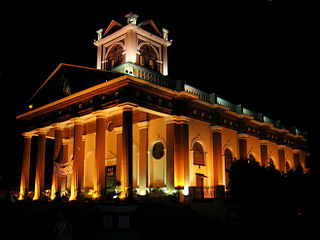
Kapurthala is a city in Punjab state of India. It is the administrative headquarters of Kapurthala District. It was the capital of the Kapurthala State, a princely state in British India. The aesthetic mix of the city with its prominent buildings based on French and Indo-Saracenic architecture self-narrate its princely past. It is also known as city of Palaces & Gardens. According to the 2011 census, Kapurthala is the least populated city in India.
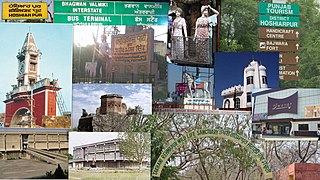
Hoshiarpur is a city and a municipal corporation in Hoshiarpur district in the Doaba region of the Indian state of Punjab. It was founded, according to tradition, during the early part of the fourteenth century. In 1809, it was occupied by the forces of Maharaja Karanvir Singh and was united into the greater state of Punjab in 1849.
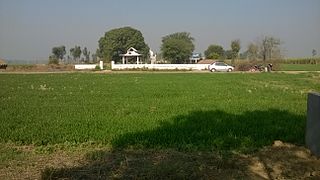
Hoshiarpur district is a district of Punjab state in northern India. Hoshiarpur, one of the oldest districts of Punjab, is located in the North-east part of the Punjab state and shares common boundaries with Gurdaspur district in the north-west, Jalandhar district and Kapurthala district in south-west, Kangra district and Una district of Himachal Pradesh in the north-east. Hoshiarpur district comprises 4 sub-divisions, 10 community development blocks, 9 urban local bodies and 1417 villages. The district has an area of 3365 km2. and a population of 1,586,625 persons as per census 2011.

Batala is the eighth largest city in the state of Punjab, India in terms of population after Ludhiana, Amritsar, Jalandhar, Patiala, Bathinda, Mohali and Hoshiarpur. Batala ranks as the second-oldest city after Bathinda. It is a municipal corporation in Gurdaspur district in the Majha region of the state of Punjab. It is located about 32 km from Gurdaspur, the headquarters of the district. It is also a Police district. Batala holds the status of the most populated town of the district with 31% of the district's total population. It is the biggest industrial town in the district.

Una is a City and a Municipal Council in Una district in the Indian state of Himachal Pradesh. It serves as the headquarters of Una district. There are 11 wards under Municipal Council. Una City is home to the Kila, which is a historical fort and an ancestral home of the descendants of the first guru of the Sikhs, Guru Nanak.

Shaheed Bhagat Singh Nagar district is one of twenty-three districts of state of Punjab, India. It is located in Doaba region. It consists of three subdivisions, Nawanshahr, Banga, and Balachaur. There are three legislative seats in the district, Nawanshahr, Balachaur and Banga. They fall under the Anandpur Sahib Lok Sabha Constituency. Nawanshahr, the district headquarters is about 92 kilometres (57 mi) from Chandigarh, the state's capital.

Doaba, also known as Bist Doab or the Jalandhar Doab, is the region of Punjab, India that lies between the Beas River and the Sutlej River. People of this region are given the demonym "Doabia". The dialect of Punjabi spoken in Doaba is called "Doabi". The term "Doaba" or "Doab" is derived from Persian دو آب meaning "land of two rivers". The river Sutlej separates Doaba from the Malwa region to its south and the river Beas separates Doaba from the Majha region to its north.
Dasuya (Dasua) is a town and a municipal council in Hoshiarpur district in the state of Punjab, India. It is one of the major subdivisions with 398 villages under its jurisdiction. This town has a great historical and mythological importance.
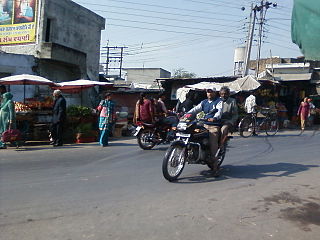
Garhdiwala is a town and a municipal council in Hoshiarpur district in the state of Punjab, India.

Mukerian is a city and municipal corporation of Hoshiarpur district in Punjab, India. Mukerian is located on National Highway 44 and state highway 15 about 450 kilometres (280 mi) north of New Delhi.It is a Sub-district headquarters situated on Jalandhar-jammu railway line and is connected by road with Jalandhar, Hoshiarpur, Talwara, Gurdaspur and Pathankot. National Highway-44 also passes through here.
Narur, also known as Naroor and sometimes Naror, is a large village in Punjab, situated 17 km from Phagwara. The area is 183 hectares with a population of 2485.
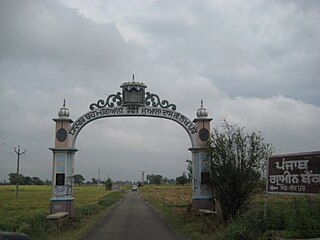
Lakhpur is a village near Sahni (Lakhpur-Sahni), Tehsil Phagwara, Kapurthala district, in Punjab, India.

Mandela is a town in the Shekhawati region and Jhunjhunu district of Rajasthan state in India.
Odhra also spelled as Odrah is a village in the Dasuya (Dasua) subdivision of the Hoshiarpur district in Punjab, India. Other names for Odhra are Ond, Odhran and Odrysian.
The Ad-Dharmi is a sect in the state of Punjab, in India and is an alternative term for the Ravidasia religion, meaning Primal Spiritual Path. The term Ad-Dharm came into popular usage in the early part of the 20th century, when many followers of Guru Ravidas converted to Sikhism and were severely discriminated against due to their low caste status. Many of these converts stopped attending Sikh Gurdwaras controlled by Jat Sikhs and built their own shrines upon arrival in the UK, Canada, and Fiji Island.Ad-Dharmis comprise 11.48% of the total of Scheduled Caste communities in Punjab.
Mangu Ram, known popularly as Babu Mangu Ram Chaudhry, was an Indian freedom fighter, a politician from Punjab and one of the founder members of the Ghadar Party.
Nurpur Jattan is a village in Hoshiarpur district of Punjab State, India. It is located 35 kilometres (22 mi) from Hoshiarpur, which is both district and sub-district headquarters of Nurpur Jattan. This village comes under mahilpur police station and garhshanker (tehsil). Sabka sarpanch was sartaj singh sangra and now ajit singh Pannu elected as a sarpanch in recent election. This village is administrated by a Sarpanch, who is an elected representative.nurpur jattan has two sikh temples and a religious place which is known as bhagat charn dass ji. A fair held on every year in october in memory of bhagat charan daas ji. The village comprises an area of 208.54 hectares.
Master Gurbanta Singh was an Indian politician, educationist and social reformer from Punjab, India.












